Neil Peart's News, Weather and Sports
South By Southwest
NeilPeart.net, May 2008
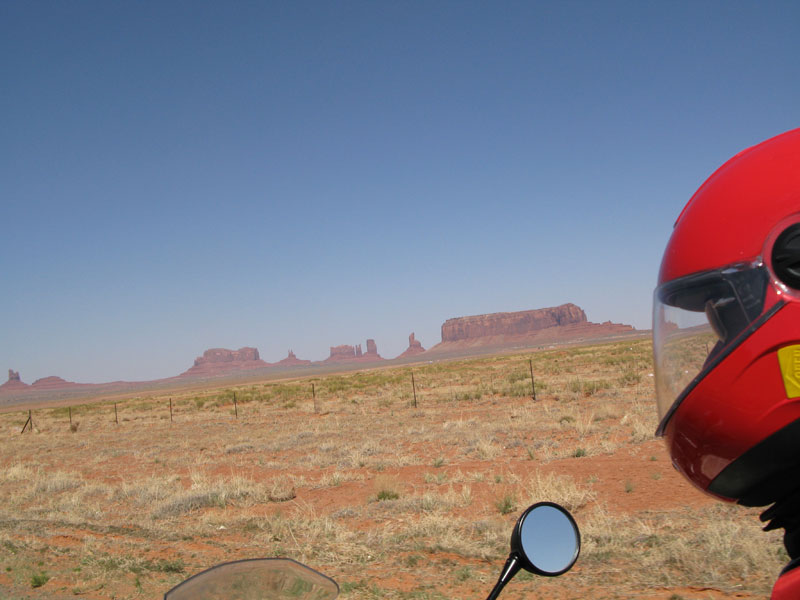
From San Juan, Puerto Rico, to Los Angeles, California, April and early May carried me through seventeen shows and more than 7,000 miles of motorcycling. That journey quite literally stretched from the farthest Southeast to the farthest Southwest of the United States, and the scenery varied from tropical rainforest and Caribbean beaches to the Everglades, remote bayous, the lofty trees of the Deep South bearded with Spanish moss, the sage and mesquite rangeland of West Texas, the massive, eroded towers of Monument Valley, the cactus desert of southern Arizona, and the wide-open, creosote-dotted expanse of the high Mojave Desert, with its Joshua trees and the distant snowpeaks of the Sierra Nevada.
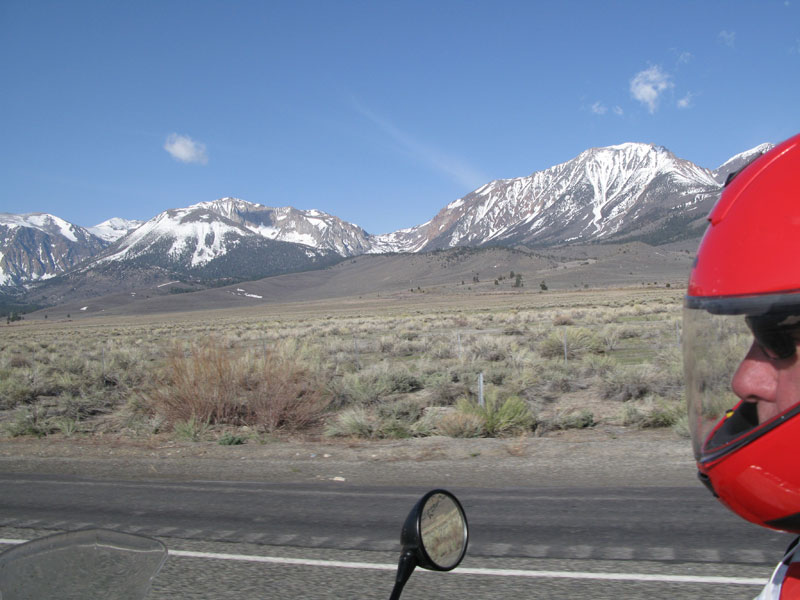
These images are part of my latest series of experiments in travel photography, a collection titled "Action Self-Portraits with Scenery." While I ride along (on a straight and empty road, of course), I hold my camera out to the side, or over my head, and snap away. The technique yields many failures, and ongoing lessons in "remote framing," but occasionally it captures the desired effect - the perspective of a helmeted rider passing through a backdrop of natural beauty.
The idea evolved when my usual riding partner, Michael, was called away on other duties, and I rode alone for a few days. Without a model, or designated photographer, I was trying to figure out how to continue my attempt to document the combination of motorcycles and landscapes. Scenery alone doesn't seem nearly as interesting without a kinetic, human element, I don't think, and parking an empty bike in front of a landscape isn't very satisfying. Not wanting to fiddle with any kind of on-bike camera mount (especially after watching Brutus struggle to get one to work for the whole European run last October), I had to come up with something comparable to the "Tip-Cam" I introduced for my cross-country skiing photos. Or like the method I made into a theme on my Ghost Rider travels - parking my old 1100GS in the middle of the road on its centerstand, with scenery all around, and the road ahead diminishing to its vanishing point.
In that spirit, when I made the long solo ride to Monument Valley during a two-day break between shows in Oklahoma City and Albuquerque (eventually riding 1000 miles in two and a half days), I was determined to recreate the cover shot from Ghost Rider. On the same stretch of road where that photo had been taken ten years ago (ten years ago? Ten lifetimes), I posed my current 1200GS.
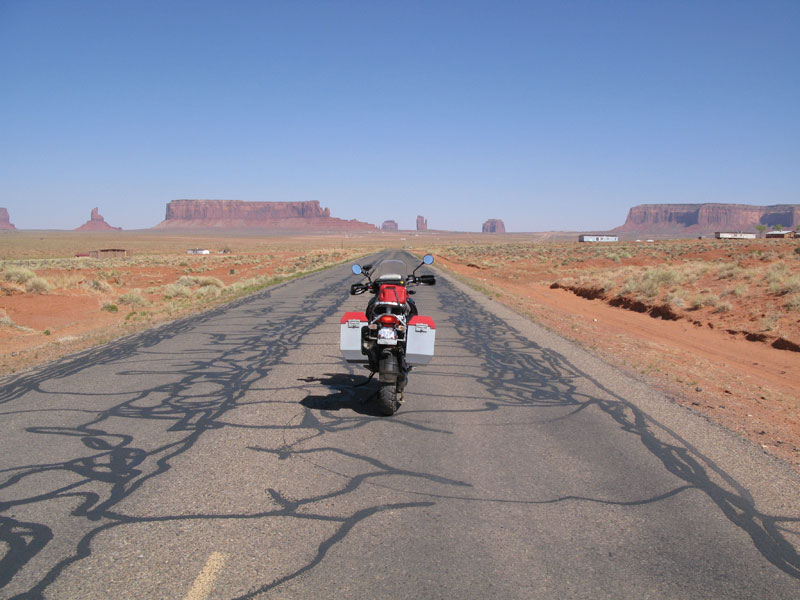
It was a stirring moment for me, haunting, resonant, and almost surreal. In those two simple images of stationary motorcycles in a stark, dramatic landscape, I connect all the journeys of the past ten years, throughout the world and throughout myself.
(Fun Fact: Ghost Rider still outsells my other books by more than double, despite its dark mood. As they used to say, go figure.)
Before the first show in San Juan, the band had already rehearsed for several weeks in March and early April, getting back into performance shape after a few months away. As usual, I began with two weeks on my own, this time at home in California, commuting to Drum Workshop's new multimedia facility just up the Pacific Coast Highway. Terry Bozzio, the ingeniously innovative percussion virtuoso ("drummer" doesn't seem sufficient) is more-or-less the artist-in-residence at DW these days, and it was inspiring to share our lunch breaks with owner Don Lombardi, watching films of masters like Buddy Rich - even slowing down Buddy's snare break in "Love for Sale" and trying to figure out, "How is he doing that?"
(Fun Fact: Buddy had a technique of turning his left wrist over, reversing the "cradle" of the stick so it approached the drumhead sideways; thus he could strike it in both directions, like a guitarist's style of alternate-picking. That's just sick.)
On my final day in that intense drum-immersion course (including playing along with our CDs and rehearsing my solo for hours every day), I took part in an impromptu percussion trio with Terry and another of my favorite drummers, Joey Heredia. That experience was both inspiring and humbling (a healthy combination).
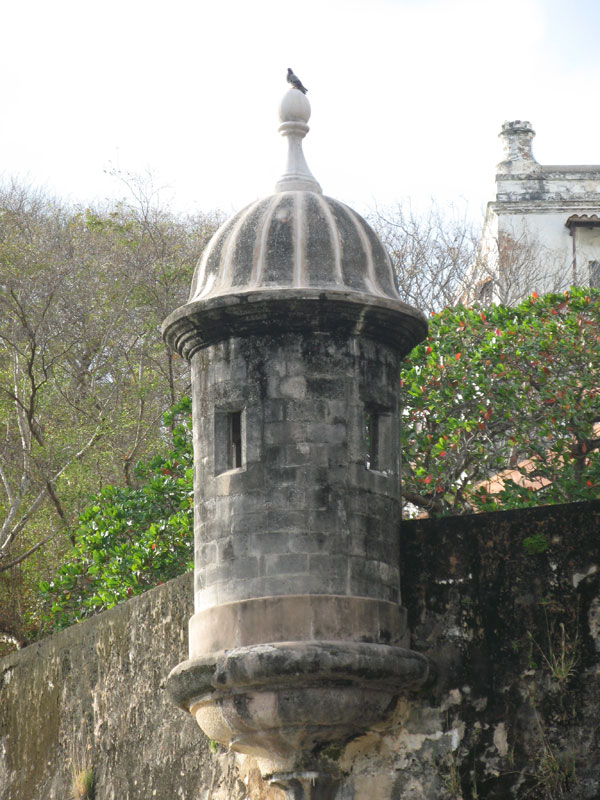
After ten days in Toronto rehearsing with "the guys at work," we spent almost a week in San Juan for full production rehearsals.
When our manager, Ray, suggested that idea back in Scandinavia last October, when Brutus and I had been freezing on the bikes every day, the notion of starting a tour in the tropics sounded pretty sweet. And it was - more than I could have imagined.
My only experience of Puerto Rico had been changing planes in San Juan many times on my way to the British Virgin Islands years ago, so my impressions were hardly ideal. With a few free days between rehearsals, or earlier on the work days, Michael and I were able to get out on our motorcycles and explore pretty widely around what proved to be a fascinating and richly scenic island. Carrie joined me for a few days, and we spent an enjoyable day poking around the ancient fort, narrow streets, and European ambience of Old San Juan. Altogether, Puerto Rico proved to be a delightful combination of influences, mingling elements of West Indian, Spanish, African, American, and Mexican culture and atmosphere.
(Fun Fact: Rum was introduced to Puerto Rico in the early 1500s by Spanish governor Ponce de Léon - who, incidentally, never once mentioned a "fountain of youth" in his writings. However, a few centuries later the piña colada was invented in Puerto Rico, and it has probably helped to rejuvenate full many an aging Yankee libido with tropical languor.)
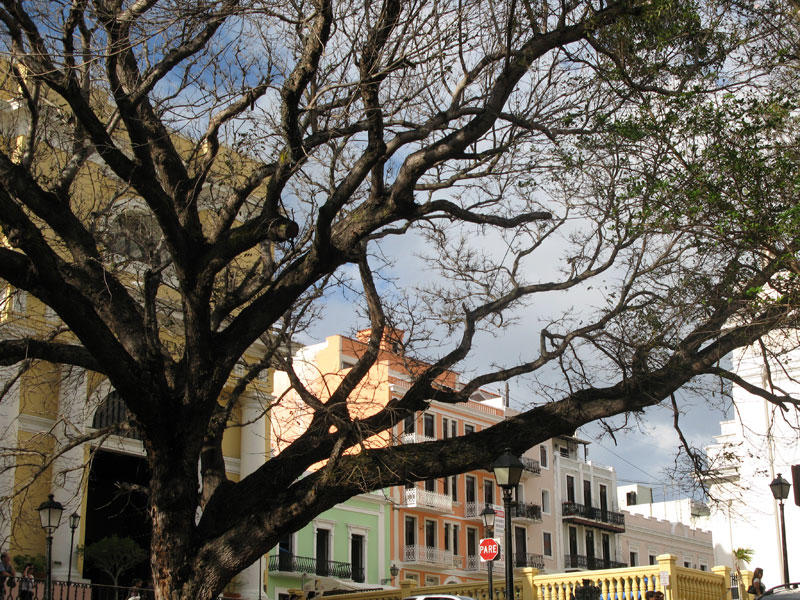
When Carrie had flown home, Michael and I had a free day before the show in San Juan, so we set out across the island's spine on a series of little roads called the Ruta Panorámica. We had made a symbolic visit to the lighthouse on the northeastern point of the island, El Faro de Las Cabezas, and now headed for the lighthouse on the far southwestern point, El Faro de Cabo Rojo. In the valleys and up the mountainsides, we rode through deep rainforest, with hanging vines and an incredible tapestry of different greens.
Most of my tropical sojourns in recent years have been to the Hawaiian Islands, whose remote location in the middle of the Pacific Ocean naturally limited the diversity of its flora and fauna (though not its lushness and beauty). Riding through the dense greenery in El Yunque National Forest, on our first ride in Puerto Rico, I was struck by the numberless variety of plants and trees, from ferns and cycads (the oldest plant form on earth - dinosaur food) to banana palms and bamboo, delicate little blossoms at the roadside, velvety mosses, and a mosaic of interlocking leaves overhead.
It might almost be said that Hawaii's relatively limited palette of greenery suggests a creationist simplicity, a pristine Eden, while Puerto Rico, collecting from North America, South America, and even the ancient supercontinent of Pangea, overflows with a complex hurly-burly of evolutionary struggle and burgeoning life. Even the smell of the Puerto Rican forest was richer, darker, and more pungent. It reminded me of another Caribbean island, Montserrat, where we recorded at Air Studios back in the '80s, and the primeval smells of the night forest as we drove back to the guest house at night after work.
(Fun Fact: Puerto Rico is classified as a United States Territory, acquired from Spain in 1898. Just after World War II there were outbreaks of violent liberationism, including the attempted assassination of President Truman, and a volley of shots in the House of Representatives that wounded five Congressmen. More recently, the people have held several indecisive referendums on whether to become a republic, a state, or retain their present status.)
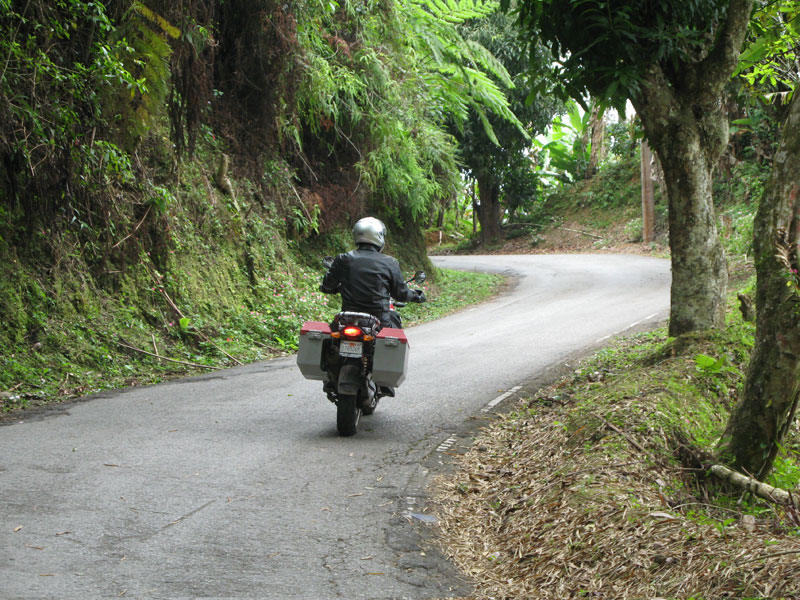
The tiny, winding roads led us up across high ridges with majestic views, the rich green valleys sloping down to the glittering turquoise and blue water - the Atlantic Ocean to the north, the Caribbean Sea to the south. The riding was challenging, over crumbling pavement in tightly-wound, narrow switchbacks, and I was reminded of certain roads in Mexico - especially El Espinazo de Diablo, "the spine of the devil," in the Sierra Madre. Other similarities to Mexican roads were the hazards of chickens, dogs, iguanas, cows, horses, ancient smoking cars and pickups, erratic driving, non-functioning brake lights and turn signals - not only unused, in the fashion of thoughtless drivers everywhere, but actually not working, their bulbs seemingly shaken to bits on the local roads. Potholes and broken shoulders were sometimes repaired with a patchwork of lumpy asphalt, and if a section of road had washed away down a cliff, they simply moved the guardrail in, greeting the oncoming rider with a sudden stretch of one-lane road. And perhaps an oncoming truck or schoolbus.
For all of those reasons, most of our cross-island ride was taken in first gear, creeping around blind hairpins with the ever-present possibility of ... anything. In steeper country, where the road was carved into loops down a mountainside, the houses were perched at the pavement's edge. With no flat ground for a driveway, say, if a guy needed to work on his car, he simply parked it on the road and jacked it up - offering yet another surprise as we rounded a blind corner.
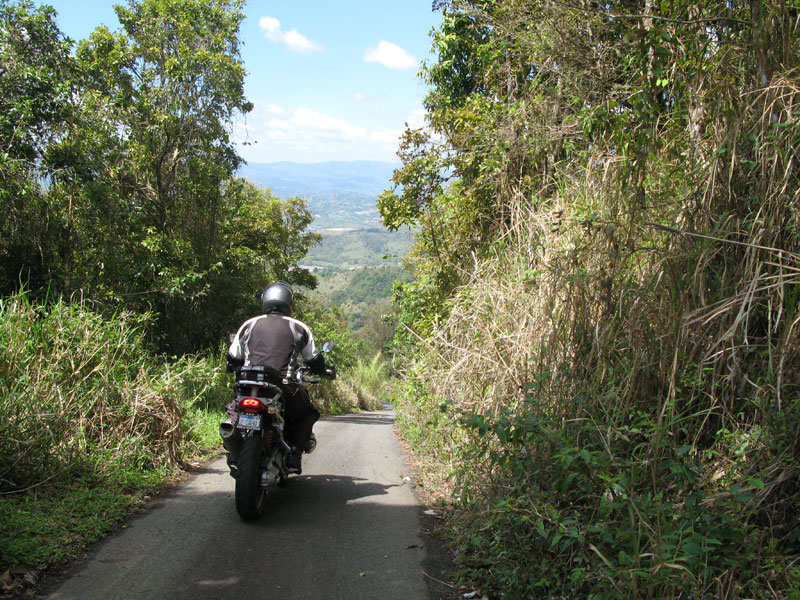 |
Michael prepares to descend the steepest road I have ever ridden. Narrow, too. |
With all that, it took us seven and a half hours to cover only 150 miles, but after such a long, hard day, we parked at the Parador Guánica 1929, a charmingly restored old hotel on the mangrove-fringed bay of Guánica.
(Fun Fact: There is a bay in Newfoundland humorously called Useless Bay, and as I looked around the inlet surrounding our hotel, a monotonous circle of mangroves broken only by an abandoned, rusting sugar mill, and signs warning against swimming - "It is prohibit" - I decided this must be Puerto Rico's version of Useless Bay.)
The next day continued with more of those sinuous mountain roads, heading north through the rugged interior, with lush vegetation, some picturesque villages, and occasional vistas of distant valleys. (To adventurous motorcyclists - Puerto Rico is definitely a recommended destination, especially if there is a motorcycle rental company there. If there isn't - start one.)
Passing the famous observatory at Arecibo, we reached the northern coast, then detoured onto a small road that followed the shore for a few miles of undeveloped beach (increasingly rare on any tropical island). After that we surrendered to the busy multi-lane toll road, and made our the way to the conurbation of San Juan, and the arena. The idyllic moment pictured below is thus not representative of our "riding dynamic" that day, nor of the hellish traffic in which we were about to be embroiled getting into San Juan, nor does it suggest the oppressive heat and humidity. But it is a pretty picture.
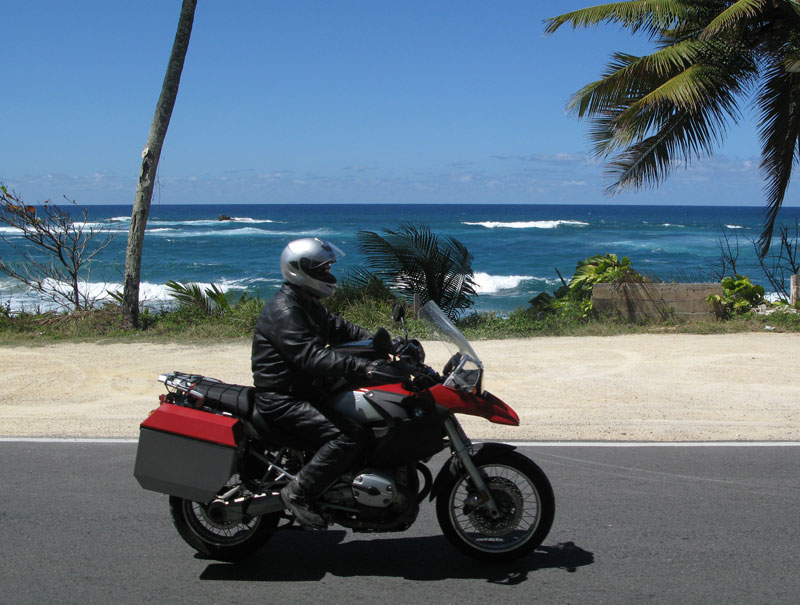
For once I'll offer up the fantasy ...
For many years I have looked longingly at a little road on the Florida map that runs all the way south through Everglades National Park, ending at a dot called Flamingo, right at the southernmost tip of Florida's cape. Once before I described the road atlas of the United States as "the Book of Dreams," and this is a fine example of the kind of elusive, remote little road that tantalizes my imagination.
That particular road, though, had always been just too far from any show for me to get there and back, even with a day off. This time I made it happen - though I paid a heavy price: a long slog north on the so-called "Florida's Turnpike," which might be my version of hell on earth, to the next show in Orlando.
The Everglades, the "River of Grass," like many of America's landscapes, can only be appreciated by traveling through it, and getting some sense of its sheer scale. Riding through the heart of the Everglades, I noticed that the roadside vegetation had the same quality as the Western deserts - the added precipitation from the pavement's runoff resulted in a greater variety, and especially size, in the plant life at the road's margins, like a naturally unnatural hedgerow. Beyond that narrow line, to every horizon stretched a vast savannah of brownish-green grass, broken only by occasional groves of tall, spindly pines.
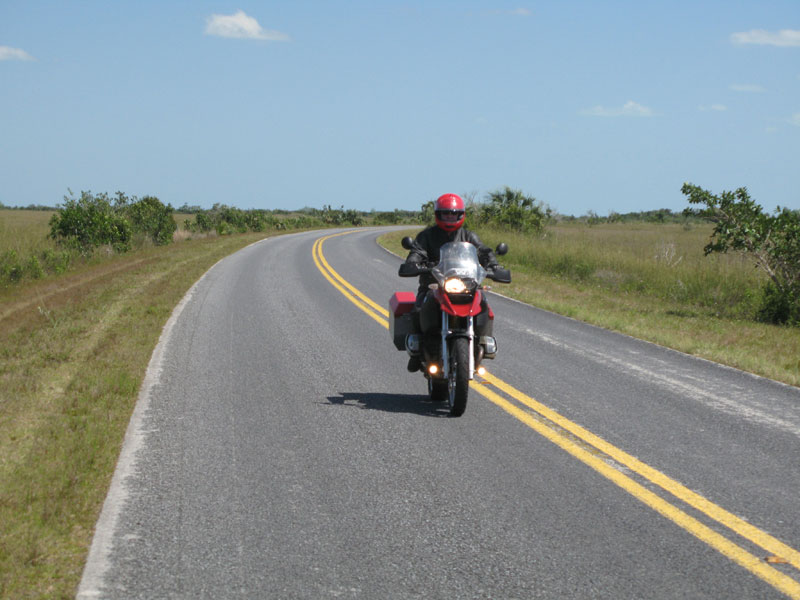
The Everglades birdlife is famously spectacular, white egrets, herons, storks, cormorants, anhingas, and other water birds plainly visible from the road. During my travels right across the South, in that season of spring migrations, I saw a great variety of birds, mostly on the fly (them and me!). Ducks, geese, hawks, falcons, grackles, doves, crows, jays, vultures, and the characteristic birds of the West, yellow-headed blackbirds, magpies, and horned larks.
(Fun Fact: You never actually see horned larks - you just know it's them by the sudden flurry as they rise in front of you from a Western road, missing you by seeming inches as they disappear in a blur.)
And speaking of national parks (as I was just before the birds distracted me), I was able to add a few more of them to my collection - and their passport stamps to the front of my journal. With a rare two-day break between shows in New Orleans and Austin, Dave drove us through the night back to Texas. Almost as soon as he had parked the bus at a truck stop in New Braunfels, I dragged Michael out of his bunk and all the way west to Big Bend National Park, which I hadn't visited since the journey recounted in Traveling Music, back in 2003.
The first 400-mile day brought us to Marathon, Texas, and a delightful old hotel called the Gage, which seemed to be popular with traveling motorcyclists. About twenty bikes were lined up in front of it, on the Route-66-style main street of Marathon - nearly every business huddled along a two-lane highway. At night it was a brief oasis of neon over a ribbon of pavement that flowed in and out through a wide desert of darkness.
Next morning we headed south and through the park, reveling in the mostly straight, empty roads framed in majestic scenery and a sense of limitless space. As I have noted before, referring to the Grand Canyon, it seems impossible to hold a landscape of such grandeur in memory. Every time I see Grand Canyon, or the Big Bend country, I am freshly amazed.
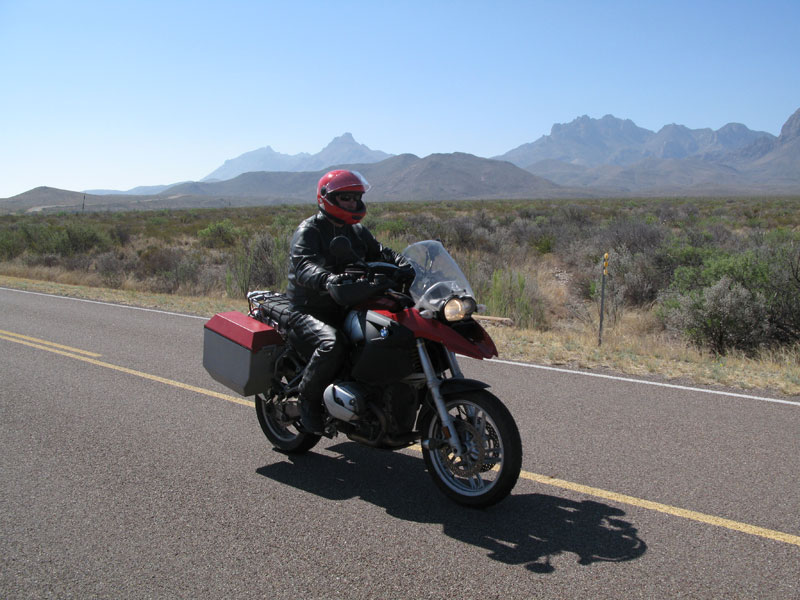
Riding north and east, putting in another 400-mile day (in 106° heat), we worked our way back toward the next show in Austin, stopping for the night in San Angelo. For the first time ever, in any of my day-off rambles, we had trouble getting rooms there. Most of the motels were filled with investigators, victims, and counselors dealing with that fundamentalist, polygamist Mormon sect in nearby El Dorado.
(Fun Fact: "Reformed" Mormons might not like it, but it could be said that those people, however benighted, and unquestionably victims and perpetrators of what right-thinking people would call abuse, were true Latter-Day Saints. They remained faithful to the divine revelations preached, and practised, by Joseph Smith and Brigham Young - that God commanded the men to have multiple, ever-younger wives. In order to achieve statehood, back in 1896, the "reformed" church put those inconvenient truths aside. Sometimes even divine revelations have to bow to good business.)
When Michael and I visited Nauvoo, Illinois, last summer, we genuinely admired the life-size equestrian statue depicting Joseph Smith and his brother Hyrum riding to the courthouse in Carthage, knowing they rode to their deaths. (They could as easily have escaped West, and abandoned their people to an increasingly-violent struggle with the neighboring "Gentiles," but as Wallace Stegner pointed out about Joseph Smith, "whatever he was, he was not a scoundrel or a coward.")
Somehow Michael got it into his twisted mind that he and I were the reincarnations of Joseph and Hyrum (never mind - I didn't even ask), and here is what might be our equestrian portrait. It is the alternate variation of the "Action Self-Portrait with Scenery," holding the camera above my head and shooting backwards.
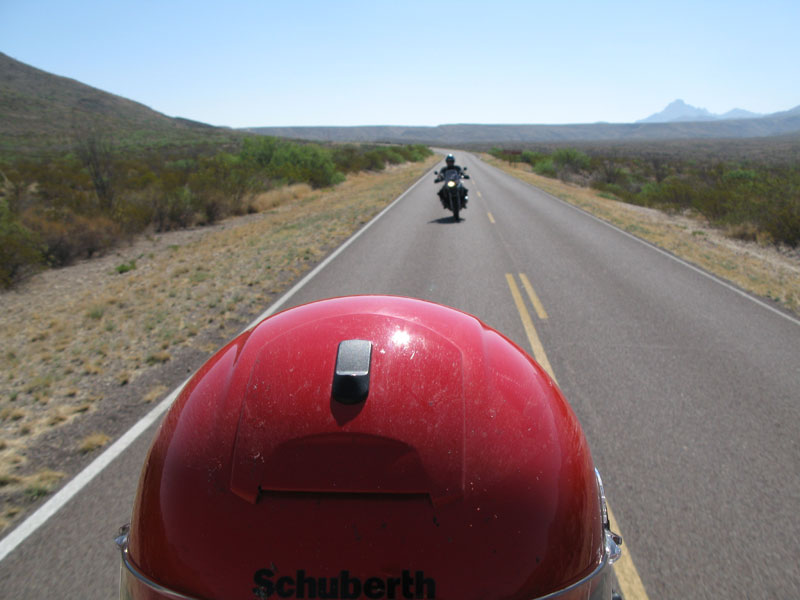
Collecting that Big Bend National Park passport stamp on April 22, a few days later I was on my way back from Monument Valley (not a national park, but a tribal park, being part of the vast Navajo reservation), riding solo, and decided I had time to make a brief stop at Mesa Verde National Park (note to riders: worth it just for the fifteen-mile ride up to the Visitors Center).
Two days after that, I began my day at Petrified Forest National Park. Usually I wake up and look out the bus window at a line of tractor-trailers in a truck stop, but that morning I was delighted to open my blinds and see the familiar arrowhead logo of the National Park Service.
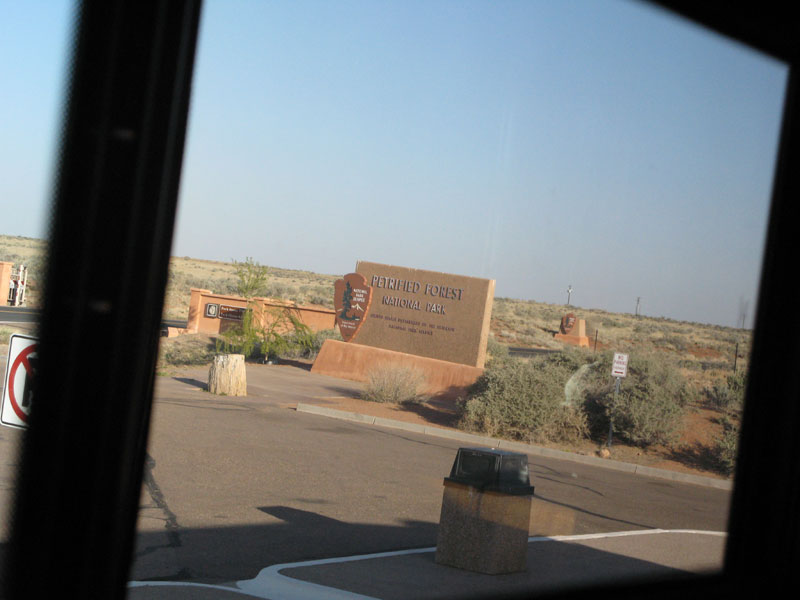
That was a fine sight to contemplate from my bed, and the beginning of perhaps my favorite day of solo riding. Through the Petrified Forest National Park, where many of the fossilized logs lay right at the roadside, broken into sections like shattered columns, I rode south into the colored strata of the badlands in the Painted Desert, then down to a simply wonderful piece of road: Highway 191 in eastern Arizona. Empty, endlessly winding in well-engineered curves of varying radius and banking, ascending through fragrant pine forests to spectacular vistas, patches of snow remaining at the roadside, though it was almost May (and in Arizona), then snaking and looping down again, the two-lane roller coaster offered a technically engaging and deeply satisfying thrill for almost a hundred miles.
I had been a little spooked about riding that highway, though, remembering that the only time I had ever been stranded by a motorcycle was on that road. As recounted in Ghost Rider, some warranty work on the 1100GS had been improperly reassembled, and the clutch shaft failed - in about as "middle of nowhere" a place as I could possibly be. Back in that fall of 1999, I sat at the roadside, reading, writing, and sipping Macallan, for about four hours before the truck and trailer arrived from the Tucson BMW dealer.
(Speaking of helpful BMW dealers, my thanks go to the service departments in North Dallas, Austin, Oklahoma City, and Reno, for some quick, friendly, and skillful work on the bikes during those 7,000 miles.)
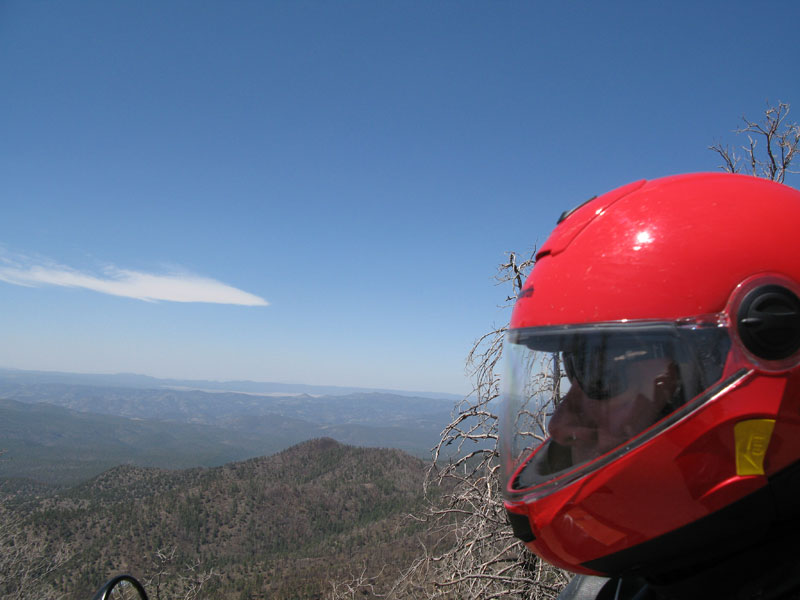
Even nine years later, I recognized that spot at the roadside very well as I zoomed past it, and continued south (with a little superstitious relief) into the mesquite grasslands around Chiracahua National Monument. Late in the afternoon, I arrived at the Copper Queen Hotel in the old mining town of Bisbee, Arizona (another revisit from my Ghost Rider travels).
Dave met me at the Copper Queen, riding my back-up bike, an older 1200GS. As he had done from Taos to Albuquerque, Dave was going to ride into Phoenix with me on the show day. (Though I don't mind riding solo, it seems irresponsible not to have a "wing man" on a show day. One bad puncture or mechanical mishap could not only leave me stranded - on the farthest reaches of a lonely road like Highway 191, say - but my failure to show up at work could disappoint an awful lot of people.)
Dave has a great affection for the Old West, and thus appreciated the preserved and restored century-old town of Bisbee, the Copper Queen Hotel, and especially, our brief pause the next morning in Tombstone.
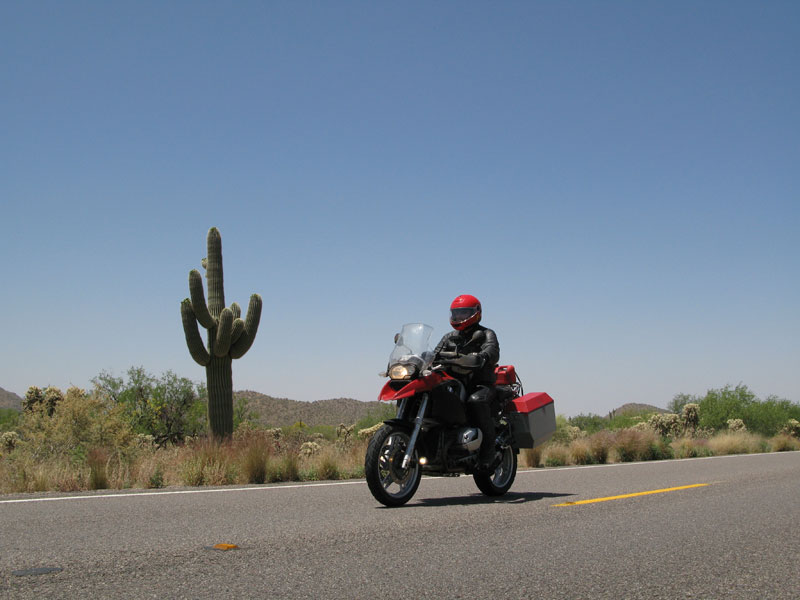
Farther west, I was joined by Greg Russell, fellow drummer and self-described "master of all things creative" (including designing this Web site, and creating the film behind my drum solo, and "Red Barchetta," this tour).
(Fun Fact: Greg shot that footage with three cameras mounted in the back of his pickup, then reversed the motion.)
Greg and I rode from a truck stop in Kingman, Arizona, up through the wilds of western Nevada on a nice stretch of remote gravel road. In this Action Self-Portrait, you can also see how windy it was, by the dust-trails swept away beside us (nicer for the following rider!).
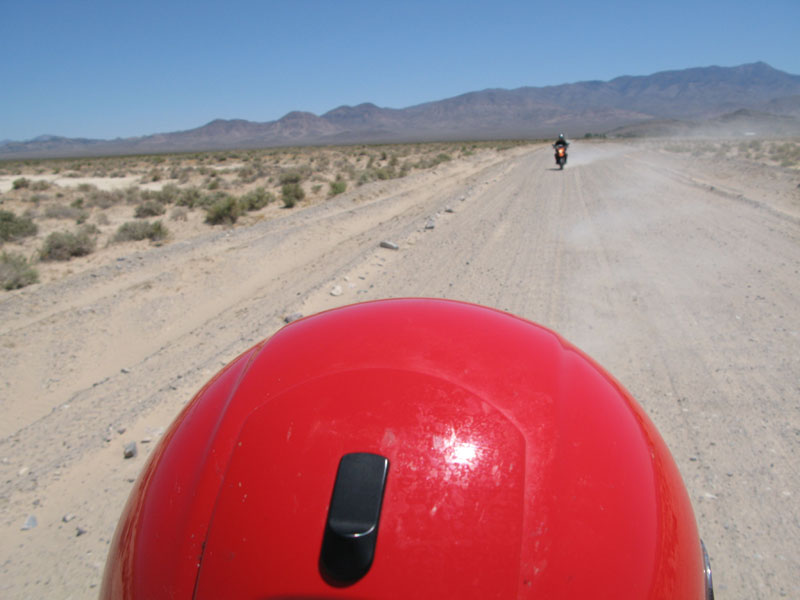
We crossed into California through the Silver Peak Range, over the fantastic Westgard Pass. I had taken that road a few times before, first led that way by Brutus on the Test for Echo tour in 1996. Narrow - sometimes one lane - and little used except by the odd RV or rancher's pickup, the Westgard Pass is a symphony in three movements, three separate stages to the crossing, with plateaus between, and each twisty section presenting different dynamics and topography.
Riding down the final stretch to the Owens Valley, we were facing those snow-streaked Sierras (as shown in the second photograph, way back at the beginning of what has become a colossal epic). This photograph, taken by the Master of All Things Creative, captured something rarely pictured in, say, motorcycle magazines. The vastness of the landscape, the flow of its contours laid bare by a low, intricate pattern of vegetation, and a banking motorcycle arcing through the distant center. I call it art.
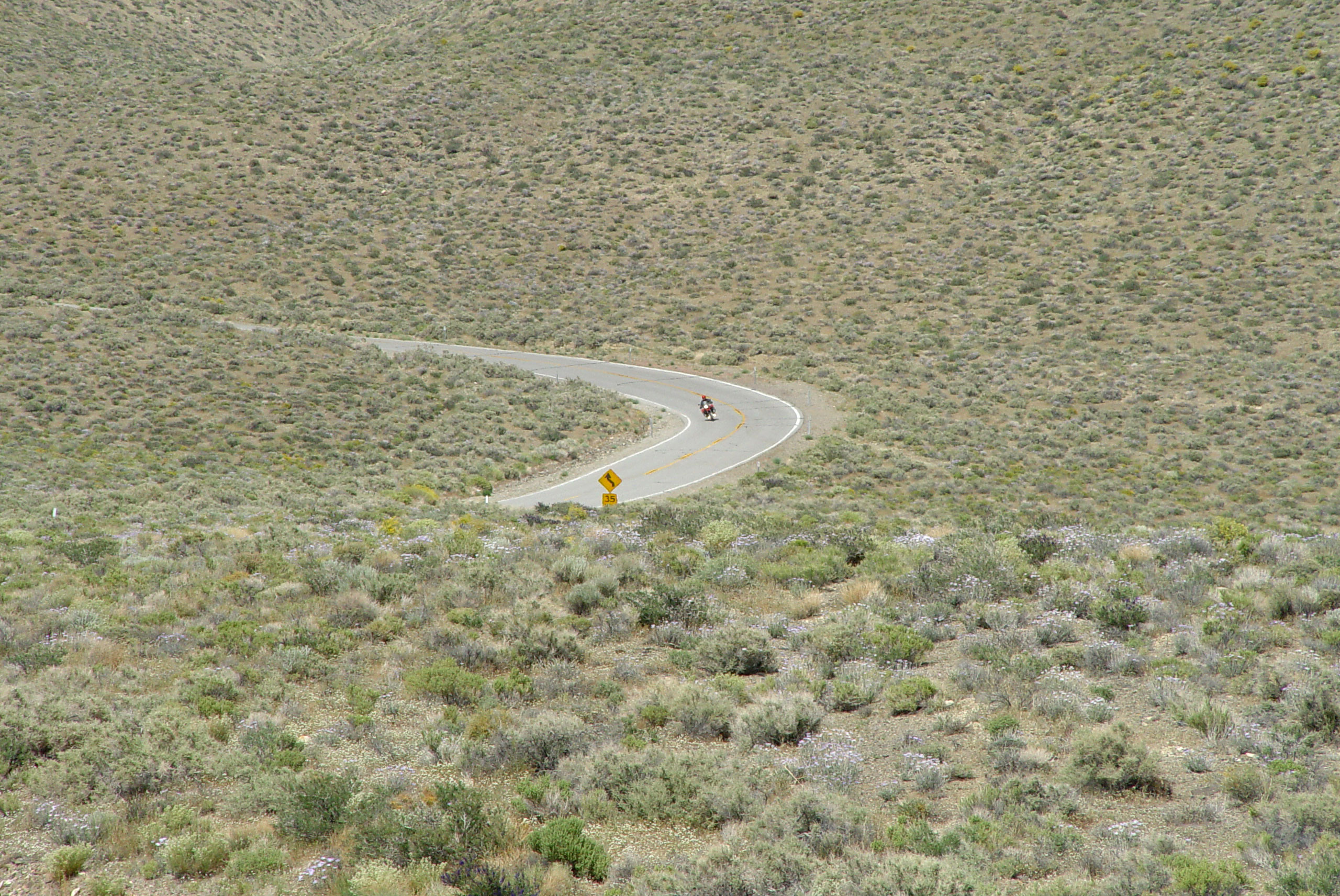
And speaking of art, particularly "performance art," let us recall that all of this motorcycling was part of a concert tour, after all. Between the days off in Monument Valley or Mono Lake, I had to show up at arenas and amphitheaters and "earn my gas money."
(Fun Fact: the fuel bill for our tour buses alone these days is a whopping $6500 per week.)
But the shows have been going very well, too. It may be my imagination, but it seemed to me that the audiences in places we hadn't played in many years, like New Orleans, Austin, and Oklahoma City, were especially appreciative, and excited that we were simply there.
(As I stood beside a bayou in Louisiana, this alligator slowly surfaced in front of me. It seemed excited that I was simply there, too. I soon wasn't.)
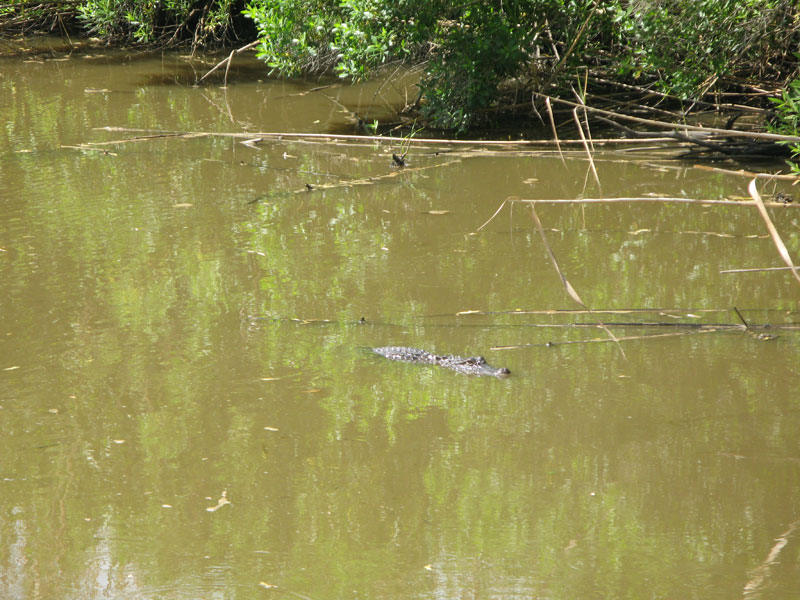
At the very end of the show in Dallas, when I stood up to bow and wave and the lights were bright on the audience, I saw a sign way back on the stage-left side: "Let Neil Sing." I laughed out loud at that. As the old saying goes, "Be careful what you wish for."
Hoping not to appear immodest (to quote Dizzy Dean again, "It ain't braggin' if you can back it up"), I have to say that I think the band is playing at its absolute peak. (And I guess that's not bragging - I'm only talking about our peak, not anybody else's!)
But each show takes so much out of us that we live in a world of hurt, especially towards the end of a long run like this one. But - it's a good hurt. It is well earned, and well rewarded. (Some of the pain comes from those 7,000 miles in the saddle, too.)
There is a saying in French, "Ça vaut la peine" - it is worth the grief, or pain. That's how I feel about those journeys, and what it takes to deliver the kind of performances we've been giving lately.
(Fun Fact: The drumming-induced calluses on my fingers sometimes split open, which lets the sweat into the tender flesh beneath. That causes a kind of nerves-on-edge torture, but I can't use a bandage, because I need the sensitivity in that "cradle" of the stick. In desperation, I tried filling the split with a drop of Krazy Glue. It really works!)
After the show, tired and sore and sitting back on the bus, I struggle to my feet to refresh my glass of Macallan with a litany of German imprecations: "Einbahnstrasse, gemütlichkeit, hauptbahnhof, ausfahrt, schadenfreude."
Which is to say, "one-way street; friendliness; train station; exit; and taking pleasure in the pain of others."
That last would describe Michael, who laughs at my pain.
(Fun Fact: Michael is an evil and unfeeling monster. I don't know how I've put up with him for three tours and 75,000 miles. Maybe it's because I enjoy insulting him so much.)
Often enough, though, my world of pain is balanced by moments of pleasure. In Roadshow I wrote about one of my favorite roads, California's Highway 33 up above Ojai, and about one of my favorite flowers - Spanish broom, which explodes in clusters of yellow blossoms in early summer along the highway edges of the West. Apart from brightening a somewhat stark palette of arid, rocky landscape, scrubby chaparral, and dark green California live oaks, during their short blooming season, those yellow flowers fill the air with an intoxicating fragrance that compares to only two other floral perfumes: lilac and jasmine.
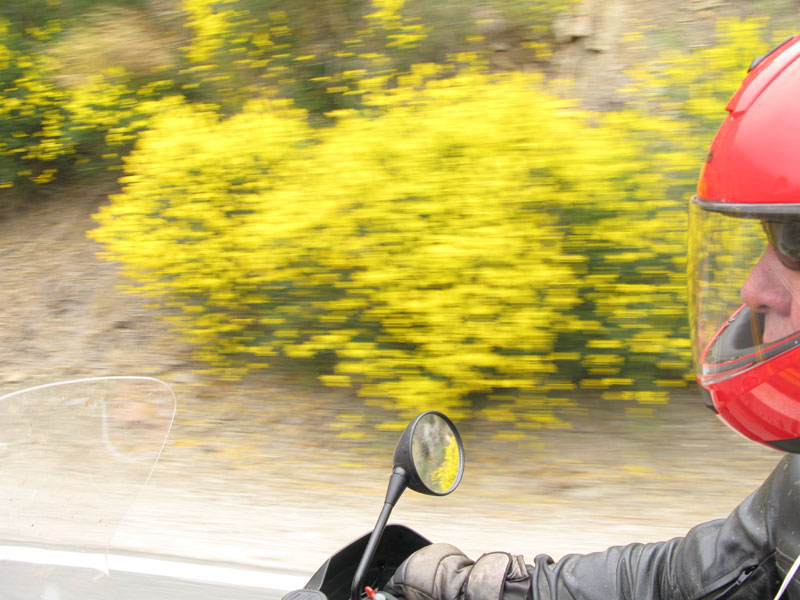
Exemplifying the favorite road and favorite flower theme, here is one of my favorite of the "Action Self-Portrait with Scenery" series - riding down that glorious Highway 33 toward home, swooping through the bends with my helmet filled with Spanish broom, after a show up in Concord, California, and after sleeping on the bus in a truck stop at the junction of Interstate 5 and state highway 99.
A final quote (which is often attributed to Mark Twain, but was actually written by the French scientist and philosopher, Blaise Pascal):
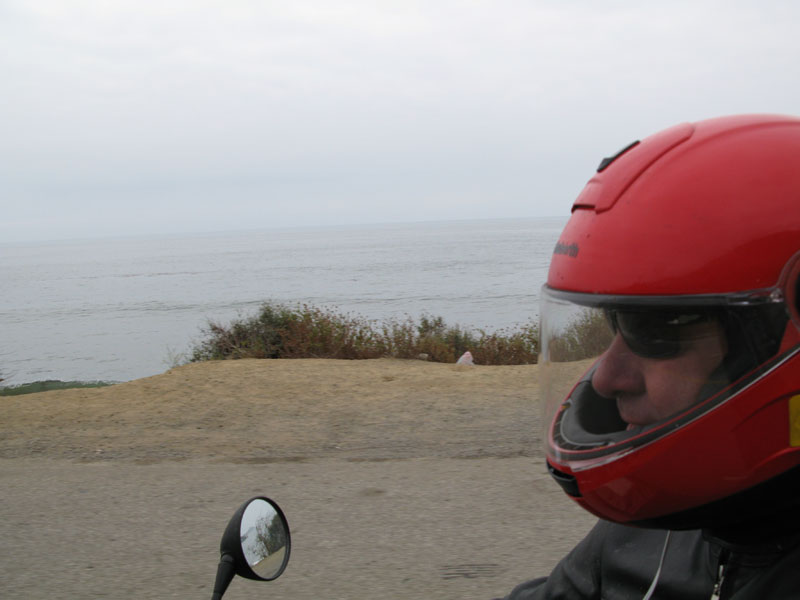
"I am sorry this letter is so long, but I did not have time to make it shorter."
(Fun Fact: The theological default called Pascal's Wager is a pusillanimous theorem stating that it's "safer" to believe in God than not, because you have nothing to lose if you're right, and everything to lose if you're wrong. All I can say to that is, "Man up, Pascal!")
A final "Action Self-Portrait with Scenery," this one of a very happy rider, motoring along the Pacific Coast Highway near Malibu, bound for home.